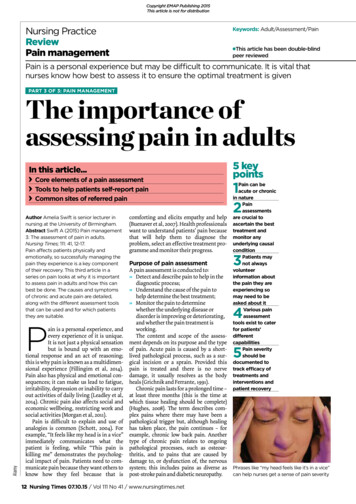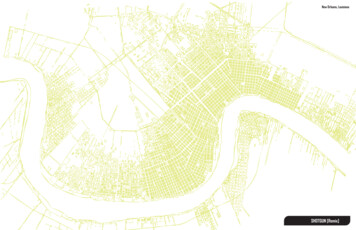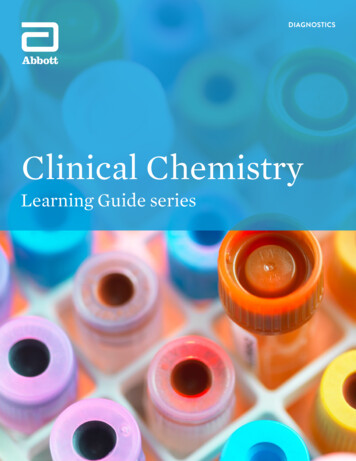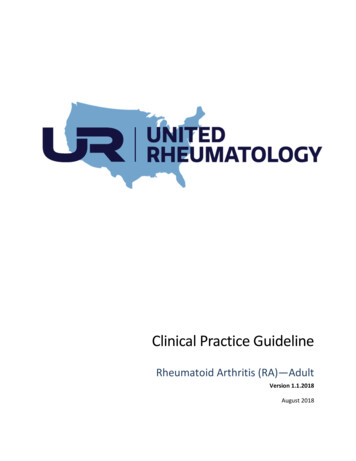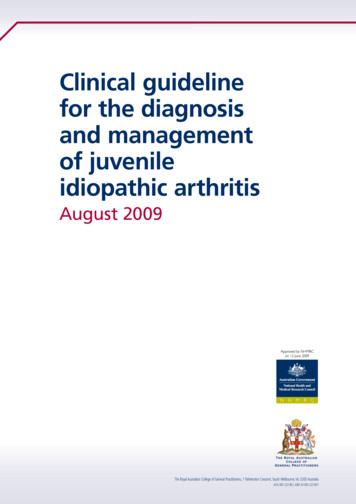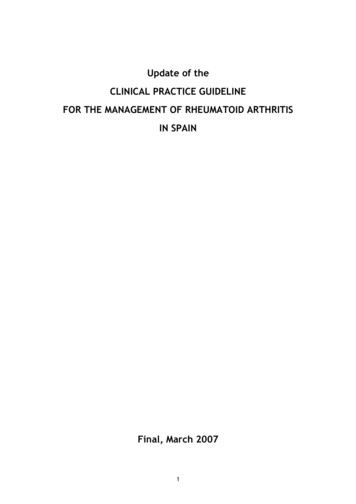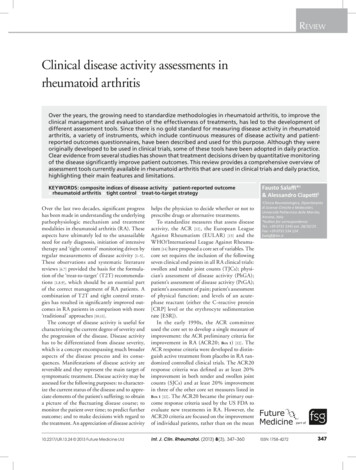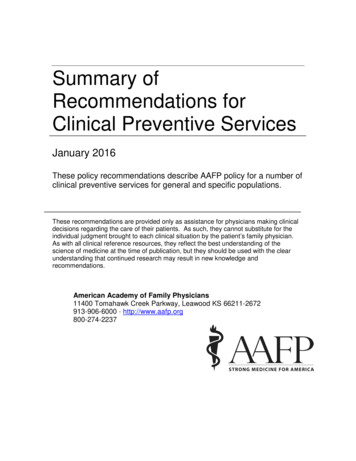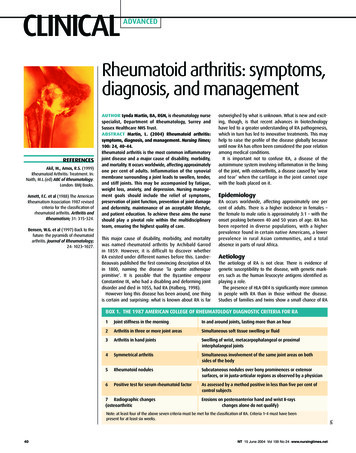
Transcription
CLINICALADVANCEDRheumatoid arthritis: symptoms,diagnosis, and managementREFERENCESAkil, M., Amos, R.S. (1999)Rheumatoid Arthritis: Treatment. In:Naith, M.L.(ed) ABC of Rheumatology.London: BMJ Books.Arnett, F.C. et al (1988) The AmericanRheumatism Association 1987 revisedcriteria for the classification ofrheumatoid arthritis. Arthritis andRheumatism; 31: 315–324.Bensen, W.G. et al (1997) Back to thefuture: the pyramids of rheumatoidarthritis. Journal of Rheumatology;24: 1023–1027.AUTHOR Lynda Martin, BA, RGN, is rheumatology nursespecialist, Department of Rheumatology, Surrey andSussex Healthcare NHS Trust.ABSTRACT Martin, L. (2004) Rheumatoid arthritis:symptoms, diagnosis, and management. Nursing Times;100: 24, 40–44.Rheumatoid arthritis is the most common inflammatoryjoint disease and a major cause of disability, morbidity,and mortality. It occurs worldwide, affecting approximatelyone per cent of adults. Inflammation of the synovialmembrane surrounding a joint leads to swollen, tender,and stiff joints. This may be accom panied by fatigue,weight loss, anxiety, and depression. Nursing management goals should include the relief of symptoms,preservation of joint function, prevention of joint damageand deformity, maintenance of an acceptable lifestyle,and patient education. To achieve these aims the nurseshould play a pivotal role within the multi disciplinaryteam, ensuring the highest quality of care.This major cause of disability, morbidity, and mortalitywas named rheumatoid arthritis by Archibald Garrodin 1859. However, it is difficult to discover whetherRA existed under different names before this. LandreBeauvais published the first convincing description of RAin 1800, naming the disease ‘la goutte astheniqueprimitive’. It is possible that the Byzantine emperorConstan tine IX, who had a disabling and deforming jointdisorder and died in 1055, had RA (Halberg, 1998).However long this disease has been around, one thingis certain and surprising: what is known about RA is faroutweighed by what is unknown. What is new and exciting, though, is that recent advances in biotechnologyhave led to a greater understanding of RA pathogenesis,which in turn has led to innovative treatments. This mayhelp to raise the profile of the disease globally becauseuntil now RA has often been considered the poor relationamong medical conditions.It is important not to confuse RA, a disease of theautoimmune system involving inflammation in the liningof the joint, with osteoarthritis, a disease caused by ‘wearand tear’ when the cartilage in the joint cannot copewith the loads placed on it.EpidemiologyRA occurs worldwide, affecting approximately one percent of adults. There is a higher incidence in females –the female to male ratio is approximately 3:1 – with theonset peaking between 40 and 50 years of age. RA hasbeen reported in diverse populations, with a higherprevalence found in certain native Americans, a lowerprevalence in rural Asian communities, and a totalabsence in parts of rural Africa.AetiologyThe aetiology of RA is not clear. There is evidence ofgenetic susceptibility to the disease, with genetic markers such as the human leucocyte antigens identified asplaying a role.The presence of HLA-DR4 is significantly more commonin people with RA than in those without the disease.Studies of families and twins show a small chance of RABOX 1. THE 1987 AMERICAN COLLEGE OF RHEUMATOLOGY DIAGNOSTIC CRITERIA FOR RA1Joint stiffness in the morningIn and around joints, lasting more than an hour2Arthritis in three or more joint areasSimultaneous soft tissue swelling or fluid3 Arthritis in hand jointsSwelling of wrist, metacarpophalangeal or proximalinterphalangeal joints4 Symmetrical arthritisSimultaneous involvement of the same joint areas on bothsides of the body5 Rheumatoid nodulesSubcutaneous nodules over bony prominences or extensorsurfaces, or in juxta-articular regions as observed by a physician6 Positive test for serum rheumatoid factorAs assessed by a method positive in less than five per cent ofcontrol subjects Note: at least four of the above seven criteria must be met for the classification of RA. Criteria 1–4 must have beenpresent for at least six weeks.40NT 15 June 2004 Vol 100 No 24 www.nursingtimes.netSPL7 Radiographic changesErosions on posteroanterior hand and wrist X-rays(osteoarthriticchanges alone do not qualify)
KEYWORDSbeing hereditary (MacGregor and Silman, 1998). Datafrom these studies shows that shared genetic or environmental factors may contribute towards developing RA.Pathological featuresThe chief characteristic of RA is an immune-drivenchronic inflammation of the synovial membrane. Thesynovial membrane surrounds the joint and producessynovial fluid that acts as a lubricant to aid smoothmovement. The outer layer of the synovial membrane iscalled the capsule, which is made up of ligaments thathold the joint in place and prevent overactivity of thejoint. When the synovial membrane is inflamed it maycause affected joints to become warm, swollen, tender,and stiff. It can lead to the synovial lining becoming continuous with vascular granulation tissue (pannus), whichgrows over the cartilage and in turn leads to erosion intothe bone (Fig 1). The result is degeneration of the cartilage and, ultimately, the joint. Joint instability, subluxation (when there is partial dislocation, with the boneends misaligned but still in contact), and deformity arethe characteristic destructive changes associated withadvanced RA (Isenberg and Morrow, 1995).Clinical featuresRA typically displays a pattern of symmetrical peripheralpolyarthritis (joints on both the left and right side of thebody are affected). Common sites include the metacarpophalangeal (MCP) and proximal interphalangeal (PIP)joints of the hand, wrist, knee, and foot. Examination ofsuch joints reveals the soft and spongy swelling of synovitis, not to be confused with the hard knobbly outgrowths of osteoarthritis. With the knee it may be moredifficult to differentiate between the thick synovitis of RAand the thin wall effusion of osteoarthritis.Other signs and symptoms of RA include: Fatigue; Joint stiffness in the morning lasting more than anhour; A general feeling of ill health or flu-like symptoms; Depression and anxiety.In its early stages RA may be difficult to diagnose withcertainty but an accepted list of diagnostic criteria wasproduced by the American College of Rheumatology in1987 (Box 1) (Arnett et al, 1988).InvestigationsThere are no pathognomonic tests for RA but there arecertain blood tests and X-rays that may support the diagnosis by adding to the overall picture as well as indicating the level of disease activity.Rheumatoid factor (RhF)Rheumatoid factor is an autoantibody, which means thatit is an antibody that fights against one of the body’sown components. Antibodies are proteins produced bythe body in reaction to a substance that the body deemsto be dangerous. A blood test for RhF may be positive inapproximately 70–80 per cent of patients with RA andNT 15 June 2004 Vol 100 No 24 www.nursingtimes.net Medicine Rheumatoid arthritisFIG 1. A NORMAL SYNOVIAL JOINT AND THEMAJOR CHANGES IN A JOINT WITH es,fibroblasts,plasma cells,dendritic cells) Joint inflammationREFERENCESBruce, B., Fries, J.F. (2003) TheStanford Health AssessmentQuestionnaire: dimensions and practicalapplications. Health and Qualityof Life Outcomes; 1, 20.Halberg, P. (1998) Rheumatoid arthritis:history. In: Klippel, J.H., Dieppe, P.A.(eds) Rheumatology. London:Mosby International.Isenberg, D., Morrow, J. (1995) FriendlyFire: Explaining Autoimmune Disease.New York, NY: Oxford University Press.CartilageSynovial fluid(neutrophils,T-cells, naturalkiller cells)Source: Moots, 2001approximately five per cent of the general population. Upto one-third of RA patients do not have it and are termedsero- negative. Those in whom RhF is present are said tobe sero-positive and this is often a more aggressive anderosive form of the disease than sero-negative RA.A titre of 1:32 is classed as weakly positive and a titregreater than 1:64 may indicate more active disease. Themain value of testing for RhF is in assessing the prog nosis of early synovitis once it has been established clinically; it is not a quick way to diagnose RA.Erythrocyte sedimentation rate (ESR)The ESR is raised when there is inflammation but this isnot specific to RA. It may be used to aid diagnosis as wellas to monitor treatment efficacy. Usually, the ESR reflectsdisease activity and may be over 100mm/hr in cases ofuncontrolled RA.C-reactive protein (CRP)This is a non-specific inflammatory marker that may beraised in the acute phase of the inflammatory response butmay not rise if inflammation is mild. Severe and uncontrolledRA is usually accompanied by a consistently raised CRP.PlateletsThe platelet count may be elevated (thrombocytosis) inproportion to disease activity. A low platelet count(thrombocytopenia) may be due to drug therapy.Haemoglobin (Hb)This may be depressed in patients with RA (normo chromic normocytic anaemia). Those with active RA withraised inflammatory markers may have an Hb of lessthan 10.0g/dL as a result high disease activity. Anaemiais common but patients taking anti-inflammatories(which may cause gastrointestinal bleeding) are also atrisk of developing iron deficiency anaemia on top of theanaemia related to chronic disease.This article has been double-blindpeer-reviewed.For related articles on this subjectand links to relevant websites see www.nursingtimes.net41
ADVANCEDREFERENCESLe Gallez, P. (1998) Patient educationand self-management.In: Rheumatology for Nurses: PatientCare. London: Whurr Publishers Ltd.MacGregor, A.J., Silman, A.J. (1998)Rheumatoid arthritis: classification andepidemiology. In: Klippel, J.H., Dieppe,P.A. (eds) Rheumatology. London:Mosby International.Moots, R. (2001) Understanding thepathogenesis. In: Haslock, I. et al (eds)Key Advances in the EffectiveManagement of Rheumatoid Arthritis.London: Royal Society of Medicine Press.RadiologyX-rays often appear normal in RA at presentation; lateron, classical juxta-articular erosions may provide diagnostic information and help monitor the progression ofthe disease. Conventionally, hand and foot X-rays areused because in many patients the first signs appear inthe metatarsal heads of the feet or in the metacarpo phalangeal joints of the hands.Treatment and managementThe goals of treatment are: Relief of symptoms; Preservation of function; Prevention of structural damage and deformity; Maintenance of acceptable lifestyle; Patient education.Patients need to have a realistic expectation of prognosis and treatment. This demands a multidisciplinaryapproach and apart from specialist nurses and consultantrheumatologists, other members of the team mayinclude physiotherapists, occupational therapists, podiatrists, chiropodists, orthopaedic surgeons, and those ableto give psychosocial support.Information, education, and understanding of RA are ofgreat importance and it is here that the nurse plays amajor role (Le Gallez, 1998). Once the initial diagnosis isconfirmed, time should be made available to discuss allaspects of the disease with the patient and the relevanttreatment options. The patient should also be given written information as appropriate to digest at home.The Arthritis Research Campaign supplies free booklets for patients and many rheumatology departmentshave developed their own patient information sheets.Arthritis Care and the National Rheumatoid ArthritisSociety run self-management courses and expert patientprogrammes. Access to the latter may be availableBOX 2. SOME COMMON SURGICALPROCEDURES IN RA Replacementarthroplasty: replacement of anentire joint or part of a joint with an artificialprosthesisarthroplasty: the ends of an articulatingsurface are excised, leaving a space that fills withfibrous tissuethrough local patient advice and liaison services.It is also important to emphasise that patients shouldpace themselves, creating a balance between exerciseand rest. Acutely inflamed joints need rest but strongmuscles help to protect joints. Maintaining a good rangeof movement is important. During an acute phase of RArest is recommended, but once this has settled exerciseof the joints with maximum range and minimum weightbearing is advised. Swimming, therefore, can be recommended as a good exercise for RA patients.Within an inpatient or outpatient setting, nurses cancollaborate with other health professionals to ensurepatients receive the best possible care. Nurses can checkthat each patient is managing an exercise programme asagreed with the physiotherapist and advise on incorporating this into the patient’s daily routine. Liaison withthe occupational therapist about joint protection (whichhelps prevent damage to inflamed joints by reducingstress) or the provision of aids to the home is also important. Care of the feet of RA patients is of utmost concernand, apart from discussing footwear, referrals to thepodiatrist, chiropodist or surgical fitter as appropriateshould be instigated without delay by the nurse.General medical or surgical ward staff may appreciatespecific advice from the rheumatology nurse concerningthe special needs of an inpatient with RA. This may includeadvice on: The handling of people with swollen and painful joints; Whether the patient requires special (higher) chairs orother furniture; Pain control; Skin care.The latter needs to be highlighted as frail or olderpatients who have had lengthy courses of steroid treatment for their RA often have extremely thin and fragileskin that can bruise, tear or break down easily.SurgerySurgery in RA is commonly undertaken to relieve painand restore function (Box 2). Mostly this is planned, as injoint replacements, but emergency surgery is indicatedin the event of septic arthritis, ruptured tendons, or compression of nerves or the spinal cord.
ABSTRACT Martin, L. (2004) Rheumatoid arthritis: symptoms, diagnosis, and management. Nursing Times; 100: 24, 40–44. Rheumatoid arthritis is the most common inflammatory joint disease and a major cause of disability, morbidity, and mortality. It occurs worldwide, affecting approximately one per cent of adults. Inflammation of the synovial
